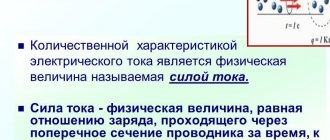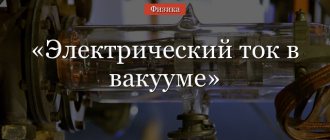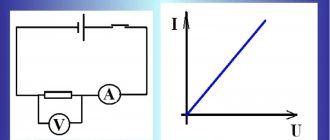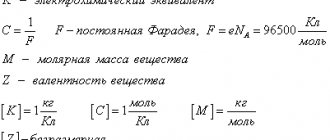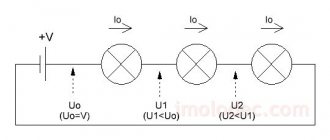4.7
Average rating: 4.7
Total ratings received: 299.
4.7
Average rating: 4.7
Total ratings received: 299.
Electrolytes are substances whose solutions or melts are capable of conducting electricity. The movement of electric current in electrolytes is called electrolysis.
Electricity transmission
Electric current is the ordered movement of charged particles. The charge carriers of electric current in electrolytes are ions. They are formed as a result of the disintegration (electrolytic dissociation) of substance molecules under the action of water molecules in solution or upon heating and the formation of a melt.
The splitting of molecules occurs due to the breaking of polar covalent or ionic bonds. The intensity of dissociation depends on the temperature and concentration of the solution. The nature of the electrolyte also influences the degree of dissociation. In this regard, the following are highlighted:
- weak electrolytes , which disintegrate partially or not at all;
- strong electrolytes that quickly break down into ions.
Weak electrolytes include most organic substances, weak acids, poorly soluble salts and insoluble bases. Strong acids, alkalis, and salts are considered strong electrolytes.
Rice. 1. The process of electrolytic dissociation.
The ions formed as a result of dissociation are divided into two types:
- cations are positively charged particles;
- Anions are negatively charged particles.
The conductor of electric current in electrolytes is the electrode. It can be an anode or cathode. The anode is connected to the positive pole of the current source, the cathode is connected to the negative pole. The anode oxidizes the substances in the electrolyte, while the cathode reduces them.
Rice. 2. Electrodes.
If two electrodes are placed in an electrolyte solution - the cathode and the anode - and an electric current is turned on, the ions will begin to move under the influence of the electric field. Cations will rush to the cathode, anions to the anode. Having reached the electrodes, the ions are neutralized, turn into neutral atoms and settle.
The process of decomposition of a substance into its constituent parts, which are deposited on electrodes, is called electrolysis.
1.15. Electric current in electrolytes
Electrolytes are commonly called conducting media in which the flow of electric current is accompanied by the transfer of matter. The carriers of free charges in electrolytes are positively and negatively charged ions. Electrolytes include many metal compounds in a molten state, as well as some solids. However, the main representatives of electrolytes widely used in technology are aqueous solutions of inorganic acids, salts and bases.
The passage of electric current through the electrolyte is accompanied by the release of substances on the electrodes. This phenomenon is called electrolysis.
Electric current in electrolytes represents the movement of ions of both signs in opposite directions. Positive ions move towards the negative electrode (cathode), negative ions move towards the positive electrode (anode). Ions of both signs appear in aqueous solutions of salts, acids and alkalis as a result of the splitting of some neutral molecules. This phenomenon is called electrolytic dissociation. For example, copper chloride CuCl2 dissociates in an aqueous solution into copper and chlorine ions:
When the electrodes are connected to a current source, the ions under the influence of an electric field begin an ordered movement: positive copper ions move to the cathode, and negatively charged chlorine ions move to the anode (Figure 1.15.1).
Having reached the cathode, copper ions are neutralized by excess electrons of the cathode and turn into neutral atoms that are deposited on the cathode. Chlorine ions, reaching the anode, give up one electron each. After this, neutral chlorine atoms combine in pairs and form chlorine molecules Cl2. Chlorine is released at the anode in the form of bubbles.
In many cases, electrolysis is accompanied by secondary reactions of decomposition products released on the electrodes with the electrode material or solvents. An example is the electrolysis of an aqueous solution of copper sulfate CuSO4 (copper sulfate) in the case when the electrodes immersed in the electrolyte are made of copper.
The dissociation of copper sulfate molecules occurs according to the scheme
Neutral copper atoms are deposited as a solid deposit on the cathode. In this way, chemically pure copper can be obtained. The ion donates two electrons to the anode and turns into the neutral radical SO4 and enters into a secondary reaction with the copper anode:
| SO4 + Cu = CuSO4. |
The resulting copper sulfate molecule goes into solution.
Thus, when an electric current passes through an aqueous solution of copper sulfate, the copper anode dissolves and copper is deposited on the cathode. The concentration of the copper sulfate solution does not change.
| Figure 1.15.1. Electrolysis of an aqueous solution of copper chloride |
The law of electrolysis was experimentally established by the English physicist M. Faraday in 1833. Faraday's law determines the amounts of primary products released on the electrodes during electrolysis:
The mass m of the substance released on the electrode is directly proportional to the charge Q passing through the electrolyte:
| m = kQ = kIt. |
The value of k is called the electrochemical equivalent.
The mass of the substance released at the electrode is equal to the mass of all ions arriving at the electrode:
Here m0 and q0 are the mass and charge of one ion, and are the number of ions that come to the electrode when charge Q passes through the electrolyte. Thus, the electrochemical equivalent of k is equal to the ratio of the mass m0 of an ion of a given substance to its charge q0.
Since the charge of the ion is equal to the product of the valence of the substance n and the elementary charge e (q0 = ne), the expression for the electrochemical equivalent k can be written in the form
Here NA is Avogadro’s constant, M = m0NA is the molar mass of the substance, F = eNA is Faraday’s constant.
| F = eNA = 96485 C/mol. |
Faraday's constant is numerically equal to the charge that must be passed through the electrolyte to release one mole of a monovalent substance at the electrode.
Faraday's law for electrolysis takes the form:
The phenomenon of electrolysis is widely used in modern industrial production.
Faraday's law
The electrolysis process was experimentally studied by the English physicist and chemist Michael Faraday in 1833. He formulated a law according to which the mass of the substance released on the electrode is directly proportional to the charge passing through the electrolyte. This law became established in science as Faraday's first law.
Rice. 3. Michael Faraday.
m = kQ = kIt,
Where:
- m is the mass of the substance;
- Q – charge;
- k – electrochemical equivalent;
- I – current strength;
- t is the duration of the current.
According to Faraday's second law, the mass of the substance released onto the electrodes is directly proportional to the ratio of molar mass to valence and is equal to the electrochemical equivalent.
m = k = M/z,
Where:
- m is the mass of the released substance;
- k – electrochemical equivalent;
- M – molar mass;
- z is the valency of the substance.
Electrolysis is used in alkaline and acid batteries. Electrolysis can be used to protect a product with a metal coating.
Electric current transmission
Electric current represents the ordered movement of free charges. To find out how electric current is conducted in solutions, you need to understand which particles are its carriers. In solids, current is created by electrons. The carriers of electric current in electrolytes are ions. These particles are formed as a result of the process of decay (electrical dissociation) of the molecules of a substance under the influence of water in solutions or upon heating and the subsequent appearance of a melt.
Molecules of substances disintegrate due to the rupture of ionic or polar covalent bonds. The number of charge carriers in the electrolyte is determined by concentration and temperature. In addition, the degree of decomposition of molecules depends on the nature of the electrolyte. As a result, they are divided into two groups:
- weak - not subject to decay or this process proceeds extremely slowly;
- strong - in such electrolytes, rapid splitting of molecules into ions is observed.
The first group includes most of the organic substances - insoluble bases, weak acids and poorly soluble salts. Strong electrolytes are alkalis, strong acids and highly soluble salts.
Electric current in liquids. Law of Electrolysis
In all the cases we previously considered, charge transfer was not accompanied by matter transfer. But there is a class of conductors in which the passage of electric current is always accompanied by chemical changes and the transfer of matter. Such conductors are solutions of many salts, acids and alkalis, as well as molten salts and metal oxides. These substances are called electrolytes.
To understand the nature of electric current in electrolytes, let's assemble an electrical circuit consisting of a current source, an incandescent lamp and a bath of distilled water in which there are two carbon electrodes. Let's close the circuit. The light does not light up. Therefore, distilled water is a dielectric.
Let's repeat the experiment by first dissolving sugar in distilled water. The lamp does not light in this case either. This means that a solution of sugar in water is also a dielectric.
Now let’s dissolve a small amount of salt, for example, copper chloride, in distilled water and repeat the experiment. As we can see, an electric current passes through the circuit, which is clearly evidenced by the glow of the lamp. The conclusion suggests itself: a solution of salt in water is a conductor of electric current.
When studying chemistry, you learned that when salts, acids and alkalis are dissolved in water, electrolytic dissociation occurs, that is, the breakdown of electrolyte molecules into ions.
In the experiment, copper chloride in an aqueous solution dissociates into positively charged copper ions and negatively charged chloride ions, which move chaotically in the absence of an electric field:
However, as soon as an external electric field is created, the chaotic movement of particles is superimposed on the directional movement of positively and negatively charged ions. In this case, positively charged copper ions move to the electrode connected to the negative pole of the current source (that is, to the cathode), and negatively charged chlorine ions move to the positive anode. At the anode, the process of oxidation of chlorine ions to chlorine atoms will occur: Cl– – e
– = Cl. And neutral chlorine atoms will form chlorine molecules, which are released at the anode: Cl + Cl = Cl2↑.
At the cathode, the process of reduction of copper ions to neutral atoms and deposition of metallic copper will occur (as evidenced by the brown coating on the cathode): Cu2+ + 2 e
– = Cu.
Thus, the free carriers of electric charge in electrolytes are positively and negatively charged ions formed as a result of electrolytic dissociation. Therefore, the conductivity of electrolytes is ionic.
Let's study the resistance of electrolytes. To do this, we will assemble a simple electrical circuit consisting of a current source, an electrolytic bath and an ammeter. By maintaining a constant voltage between the electrodes, we bring them closer to each other. It is easy to see that the ammeter shows an increase in current in the circuit.
Now we install one of the electrodes so that part of it protrudes above the surface of the solution - the ammeter readings decrease.
Thus, as the distance between the electrodes and the overlap area of the electrodes decreases, the electrolyte resistance decreases.
Now let's heat the electrolyte. As you can see, with increasing temperature, the ammeter readings increase. Consequently, an increase in the temperature of the electrolyte leads to a decrease in its resistance.
Now let's increase the voltage between the electrodes by an integer factor. It is not difficult to notice that the ammeter readings in this case also increase by an integer number of times, proportional to the voltage. This indicates that Ohm's law is satisfied for electrolytes:
Let us also note the fact that when an electric current passes through the electrolyte, the thermal effect of the current manifests itself, that is, the Joule-Lenz law is satisfied:
Go ahead. When studying chemistry, you learned that the process of releasing a substance on an electrode associated with redox reactions that occur when an electric current passes through solutions (melts) of electrolytes is called electrolysis.
The first law of electrolysis was experimentally established by Faraday in 1833. According to it, the mass of the substance released on the electrode is directly proportional to the electric charge passing through the electrolyte:
m
=
kq
.
Proportional factor k
in the formula is called
the electrochemical equivalent of a given substance.
It is numerically equal to the mass of the substance released on one of the electrodes when a single electric charge passes through the electrolyte. In SI, the electrochemical equivalent is measured in kilograms per coulomb: [ k
] = [C/kg].
But let’s return to the first law of electrolysis and remember that the charge passing through the cross section of a conductor (in our case, through an electrolyte solution) per unit time can be found as the product of the current strength and the time of its passage: q
=
It
.
The mass of the substance released on the electrode when an electric charge passes through the electrolyte can be determined by knowing the mass of one ion and the number of ions deposited on this electrode: m
=
m
0
N
.
And the mass of one ion is easy to find, knowing the molar mass of the substance and Avogadro’s number:
Let us express the number of ions from the last two formulas:
Now remember, we can determine this number of ions as the ratio of the charge passing through the electrolyte to the charge of one ion, which is a multiple of the elementary charge:
In the written formula n
is the valence of the ion.
Equating the right-hand sides of the last two equalities, we find the mass of the substance released at the cathode.
Comparing the resulting expression with the first law of electrolysis, it is easy to obtain a formula for determining the electrochemical equivalent of a substance:
The product of two universal constants is called Faraday's constant:
And the ratio of the molar mass of a substance to the valency of the ion is called the chemical equivalent of the substance:
This implies Faraday’s second law for electrolysis: the electrochemical equivalents of substances are proportional to their chemical equivalents:
Now let's substitute the expression for the electrochemical equivalent of a substance into the first law of electrolysis:
The resulting expression is called Faraday's unified law for electrolysis.
According to this law
, the mass of a substance released on each of the electrodes is proportional to the molar mass of the ions of this substance, the strength of the current and the time of its passage through the electrolyte and is inversely proportional to the valence of the ions of the substance.
Using the law of electrolysis, you can determine the value of the electron charge:
In 1874, it was in this way that the value of the elementary electric charge was first obtained.
And now, to consolidate the material, we will solve this problem with you. Chrome plating of a thin rectangular plate of dimensions a
= 5.0 cm and
b
= 8.0 cm in a large galvanic bath is carried out for three hours at a current of 1.5 A. Determine the thickness of the chromium layer formed on the plate.
In conclusion of the lesson, we note that electrolysis has found wide application in technology. For example, the English chemist and one of the founders of electrometallurgy, Sir Humphry Davy, developed a method for producing metals with the least amount of impurities.
Electrolysis is used to apply protective and decorative coatings to metal products (this is called electroplating).
In 1836, Russian academician Boris Semyonovich Jacobi developed a method for producing perfect copies of the original object. It was called galvanoplasty.
The first product obtained using electroplating technology was a coin. Jacobi first used the coin to obtain a negative matrix, and from it he created a copy of the coin that is in circulation. Realizing that he had discovered a new method of counterfeiting, the scientist destroyed the resulting product. The technology quickly spread throughout the Russian Empire. In particular, sculptures were created in this way on the naves of St. Isaac's Cathedral in St. Petersburg.
Electrolysis is also used to produce electronic circuit boards, which serve as the basis for all electronic products. A thin copper plate is glued onto the dielectric, onto which a complex pattern of connecting wires is painted with special paint. Then the plate is placed in an electrolyte, where the areas of the copper layer that are not covered by paint are etched. After this, the paint is washed off, and the details of the microcircuit appear on the board.
Electrical dissociation
This is a fundamental process for the appearance of electric current in solutions, so it needs to be considered in more detail. All ions formed during the decay of molecules can be divided into 2 types:
- Anions. They have a negative charge.
- Cations. They have a positive charge.
Most of the properties of water are due to the polarity of the molecules of the substance. In other words, from the point of view of electrical engineering they are dipoles. Here we should recall the definition of a dipole - a system of two particles located close to each other. Moreover, their charges are opposite in sign, but identical in magnitude. The polarity property of H2O is explained by the geometric structure of the molecules of the substance:
- the angle between the central lines of the atoms is approximately 104.5 degrees;
- electrons are shifted towards oxygen.
Being dipoles, water molecules are able to create an electric field around themselves, which affects not only them, but also the particles of the dissolved substance.
To establish the nature of the process of decomposition of molecules into ions, we should consider a solution of table salt. There is only 1 electron in the outer orbit of the sodium atom. His connection with the atom is weak, so he is able to quickly leave his place. The chlorine atom already has 7 electrons in its outer orbit and is one particle short of the complete set. Due to this, during the formation of a NaCl crystal, the outer electron of sodium is added to the chlorine atom. As a result, a dipole is formed.
The interaction of two types of dipoles contributes to the activation of the dissolution process. If you place 2 electrodes in an electrolyte solution - the cathode (negative) and the anode (positive), then free ions will rush towards them. In this case, the direction of their movement follows specific rules:
- cations will go to the cathode;
- anions begin to move towards the anode.
As soon as the electric current carriers reach the electrodes, they lose their charge, turning neutral, and settle on the surface of the electrodes.
